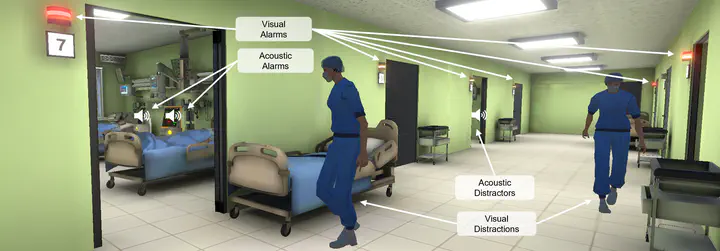Investigating the Effects of Selective Information Presentation in Intensive Care Units Using Virtual Reality
 : Insight into the virtual intensive care unit.
: Insight into the virtual intensive care unit.Abstract
Medical personnel working in intensive care units (ICUs) are continuously exposed to a multitude of alarms emanating from various monitoring devices, such as cardiac monitors, ventilators, or infusion pumps. The sheer volume of alarms, coupled with high false positive rates, can lead to alarm fatigue. This phenomenon compromises patient safety and places an additional burden on nurses who must diligently prioritize and respond to alarms in the highly dynamic environment. While the testing of stress-reducing strategies in a real ICU is challenging, virtual reality (VR) represents a powerful tool and methodology to simulate an ICU environment and test optimization scenarios for alarm display strategies. For example, redistributing alarms to responsible individuals (personalized information presentation) has been proposed as a solution, but testing in real ICU environments is not applicable due to critical patient safety. In this paper, we present a VR simulation of an ICU to simulate comparable stress situations, as well as to assess the impact of a selective and personalized alarm representation strategy in an evaluation study in two conditions. A stress condition mirrors the current ubiquitous audible alarm distribution in most ICUs, where alarms are heard non-patient-specific throughout the ward. In an experimental condition, alarms are filtered patient-specific to reduce information overload and noise pollution. Our user study with medical personnel and novices shows that stress levels can be simulated with our system as indicated by physiological responses. Further, we show that the perceived task load can be reduced with selective information presentation. We discuss the potential benefits of ICU simulations as a methodology and personalized alarm distribution as a first potential strategy for future technologies in ICUs.